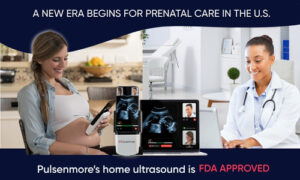Le Vance J., Gurney L., Morris K., Hodgetts Morton V.
Institute of Applied Health Research, University of Birmingham
Birmingham Women’s and Children’s NHS Foundation Trust
Introduction
- High-risk pregnancies will undergo regular antenatal cardiotocography (CTG) and ultrasound (USS).
- This can become a psychological expense to women, whilst creating a capacity issue within obstetric services.
- Recently there has been an emergence of sophisticated remote telehealth interventions.
- Our aim was to evaluate the feasibility home CTG and home USS monitoring for high-risk pregnancies.
- Participants continued their routine antenatal care alongside remote device usage.
Methods
- This was a single center feasibility study.
- Women aged ≥18 years, English speaking, singleton pregnancy, ≥32 weeks gestation and had at least one of four high-risk obstetric conditions were eligible for recruitment.
- Participants were randomised to one of three groups: (1) home USS; (2) home CTG; and (3) both (Figure 1). Images/recordings were uploaded for remote review.
- Primary outcome: completion of 20 minutes of interpretable fetal heart recording and/or completion of an interpretable fetal USS for each
monitoring episode. - USS interpretability was assessed for three validated criteria: fetal heartbeat, fetal movements and liquor volume assessment.
- Secondary outcomes: monitoring adherence, anxiety management, acceptability and safety.
Results
- 15 participants completed 59 remote CTGs and 24 remote USS.
- 75% of all CTGs contained at least 20 minutes of continuous interpretable computerised fetal heartrate recording (Figure 2).
- Overall, the fetal heartbeat, movements and liquor volume assessment were identified in 92%, 83% and 100% of all USS respectively (Figure 3).
- 79% of all scans had all three criteria unanimously assessed.
- Neither ethnicity, parity, BMI nor fetal presentation were significant factors for achievement of the primary outcome within both devices.
- There was non-significant reduction in anxiety scores before and following device usage (p=0.19) (Figure 4). Participants’ monitoring adherence and acceptability ratings were high in all groups.
- 8 CTG episodes required referral into hospital for assessment.
- No adverse maternal-fetal outcomes occurred.
Conclusion
- Home ultrasound and CTG are potentially feasible and acceptable to high-risk pregnant women.
- Larger studies are required to refine how best to implement such devices within clinical practice.
- To our knowledge, this is the first feasibility study to combine the use of both remote technologies.
https://www.obstetrics-gynaecology-journal.com/article/S1751-7214(25)00106-X/abstract


